Topology Analysis of the Access/Aggregation Network Structure in Future Optical Access Networks
Konferenz: Photonische Netze - 11. ITG-Fachtagung
03.05.2010 - 04.05.2010 in Leipzig, Germany
Tagungsband: Photonische Netze
Seiten: 6Sprache: EnglischTyp: PDF
Persönliche VDE-Mitglieder erhalten auf diesen Artikel 10% Rabatt
Autoren:
Hülsermann, Ralf; Lange, Christoph (Deutsche Telekom AG, Laboratories, Goslarer Ufer 35, 10589 Berlin)
Inhalt:
Increasing demand for higher bitrates in access networks requires fiber deployment closer to the customer as bitrates in copper based access networks are strictly limited essentially by the length of the copper cables. Besides enabling higher access bitrates optical access network technologies will also enable a change in the structure of the access/aggregation network segment due to the superior transmission characteristics of optical fibers: Larger service areas and a decreased overall number of access sites are feasible. Concentration of active network equipment in a fewer number of access site is expected to help to reduce the total cost of ownership of the whole network due to concentration effects and OpEx savings. In this paper we present results of a topology related network study investigating feasible network structures in next generation optical access networks. Starting from the structure of copper based access networks in Germany, traditional service areas are clustered to larger entities. We distinguish between different levels of access network concentration leading to various scenarios relying on a different number of required metro access nodes. A exemplary set of reference service areas is identified representing the majority of all service areas within a certain category and typical characteristics of the reference service areas are given. From the results of the topological analysis some requirements with respect to next generation optical access systems are derived.


